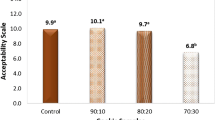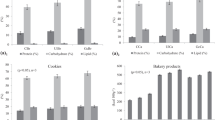Abstract
The antioxidant activities and nutritional properties of Jeonyak made with beef bone stock and gelatin were investigated. Traditional Jeonyak (J1) was prepared with beef bone stock, whereas modified Jeonyak was made with gelatin and honey (J2) or with gelatin and oligosaccharides (J3). All 3 kinds of Jeonyak had antioxidant activities and J1 had the highest activity. The α-glucosidase inhibitory activity was measured to investigate the antidiabetic effect and J3 had the highest inhibitory activity of 80.47%. Glycine was the most abundant amino acid in all 3 kinds of Jeonyak. Both traditional and modified Jeonyaks have antioxidative and antidiabetic effects, suggesting that Jeonyak can be used as an effective traditional functional food.
Similar content being viewed by others
References
Kim AJ, Han MR, Jung KH, Kang SJ. Quality characteristics of brown rice Dasik addition of white, red and black ginseng powder. Korean J. Food Nutr. 22:63–68 (2009)
Lee HJ. Korea’s Food Culture. Shinkwang Publishing Company, Seoul, Korea. pp. 38–39 (1998)
Kang YJ, Jung HS, Yoo MJ. Study on Jeonyak in the bibliography. Korean J. Food Culture 26:621–628 (2011)
Vinson JA, Hontz BA. Phenol antioxidant index: Comparative antioxidant effectiveness of red and white wines. J. Agr. Food Chem. 43:401–403 (1995)
Noh WS, Heo SH. Nutritional Supplement and Functional Food. Hyoil Publishing Company, Seoul, Korea. pp. 346–350 (2000)
Institute of Korean royal cuisine. Joseon Mussang Sinnsik Yorijebup (Chosun Dynasty Cook book). Institute of Korean Royal Cuisine, Seoul, Korea. p. 60 (2001)
Institute of Traditional Korean Food. The Beauty of Korean Food. Hollym Corp., Seoul, Korea. p. 200 (2007)
AOAC. Official Method of Analysis of AOAC Intl. 15th ed. Method 920.153. Association of Official Analytical Chemists, Washington, DC, USA (1990)
KFDA. Official Methods of Analysis. The Korea Food and Drug Administration, Seoul, Korea. pp. 313–317 (2009)
Swain T, Hillis WE. The phenolic constituents of Prunus domestica. L. — The quantitative analysis of phenolic constituents. J. Sci. Food Agr. 10:63–68 (1959)
Blois MS. Antioxidant determination by the use of a stable free radical. Nature 26:1199–1200 (1958)
Yildirim A, Mavi A, Kara AA. Determination of antioxidant and antimicrobial activities of Rumex crispus L. extracts. J. Agr. Food Chem. 49:4083–4089 (2001)
Lu Y, Foo LY. Antioxidant activities of polyphenols from sage (Salvia officinalis). Food Chem. 75:197–202 (2001)
Zhu YP, Yin LJ, Cheng YQ, Yamaki K, Mori Y, Su YC, Li LT. Effect of sources of carbon and nitrogen on production of Bacillus subtilis B2. Food Chem. 109:737–742 (2008)
Jeong HY. Quality characteristics and medicated diet therapy evaluation of Jeonyak. MS thesis, University of Myongji, Seoul, Korea (2010)
Tetiana AK, Viktor YB, Nina AB, Tetiana SI. Some macronutrient content in mycelia and culture broth of medicinal mushrooms cultivated on amaranth flour. Int. J. Med. Mushr. 14:285–293 (2012)
Yoo SH, Park BS, Jeon KH, Yoo IJ. Comparison of physicochemical characteristics among Hanwoo, Holstein and imported oxfeet jelly. Korean J. Food Sci. Ani. Resour. 14:224–228 (1994)
Golan A, Jelen P. Nutritional evaluation of low temperature alkaline extracts from beef bones. J. Food Sci. 44:332–338 (1979)
Park DY. Minerals, total nitrogen and free amino acid contents in shank bone stock according to boiling time. J. Korean Soc. Food Nutr. 15:243–248 (1986)
Moon SJ, Sohn KH, Kim HK. A study on the physical and chemical properties of gelatin foods. J. Korean Home Econ. Assoc. 16:47–55 (1978)
Amiot MJ, Aubert S, Gonnet M, Tacchini M. The phenolic compounds in honeys preliminary study upon identification and family quantification. Apidologie 20:115–125 (1989)
Tomás-Barberán FA, Martos I, Ferreres F, Radovic BS, Anklam E. HPLC flavonoid profiles as markers for the botanical origin of European unifloral honeys. J. Sci. Food Agr. 81:485–496 (2001)
Meda A, Lamien CE, Romito M, Millogo J, Nacoulma OG. Determination of the total phenolic, flavonoid and proline contents in Burkina Fasan honey, as well as their radical scavenging activity. Food Chem. 91:571–577 (2005)
Snow MJ, Manley-Harris M. On the nature of non-peroxide antibacterial activity in New Zealand manuka honey. Food Chem. 84:145–147 (2004)
Wu HC, Shiau CY, Chen HM, Chiou TK. Antioxidant activities of carnosine, anserine, some free amino acids and their combination. J. Food Drug Anal. 11:148–153 (2003)
Martins SIFS, Jongen WMF, Boekel Van MAJS. A review of Maillard reaction in food and implications to kinetic modelling. Trends Food Sci. Technol. 11:364–373 (2001)
Munari M, Mastrocola D, Nicoli MC, Lerici CR. Review of nonenzymatic browning and antioxidant capacity in processed foods. Trends Food Sci. Technol. 11:340–346 (2001)
Kwak IS, Kim HJ, Oh SB, Chung BW, Jahng KY. Antioxidant activity of Maillard browning reaction products from the various sugars and amino acids model system. J. Eng. Res. 36:9–15 (2005)
Lee KB. Food Analysis. Yu Han Sa, Seoul, Korea. p. 310 (2002)
Lertittikul W, Benjakul S, Tanaka M. Characteristics and antioxidative activity of Maillard reaction products from a porcine plasma protein-glucose model system as influenced by pH. Food Chem. 100:669–677 (2007)
Sato M, Ramarathnam N, Suzuki Y, Ohkubo T, Takeuchi M, Ochi H. Varietal differences in the phenolic content and superoxide radical scavenging potential of wines from different sources. J. Agr. Food Chem. 44:37–41 (1996)
Gheldof N, Engeseth NJ. Antioxidants capacity of honeys from various flora sources based on the determination of oxygen radical absorbance capacity and inhibition of vitro lipoprotein oxidation in human serum samples. J. Agr. Food Chem. 50:3050–3055 (2002)
Lee EH, Ham JY, Ahn HR, Kim MC, Kim YC, Pan CH, Um BH, Jung SH. Inhibitory effects of the compounds isolated from Sargassum yezoense on α-glucosidase and oxidative stress. Korean J. Pharmacogn. 40:150–154 (2009)
Kim HY. Effect of oligosaccharide and acarbose on blood glucose regulation. J. Yongin Uni. 21:517–530 (2003)
Choi HJ, Kang JS, Choi YW, Jeong YK, Joo WH. Inhibitory activity on the diabetes related enzymes of Tetragonia tetragoninodes. Korean J. Biotechnol. Bioeng. 23:419–424 (2008)
Author information
Authors and Affiliations
Corresponding author
Rights and permissions
About this article
Cite this article
Ku, S.K., Seo, D.W., Kim, S.I. et al. Antioxidant activities and nutritional properties of Jeonyak prepared with beef bone stock and gelatin. Food Sci Biotechnol 23, 81–87 (2014). https://doi.org/10.1007/s10068-014-0011-x
Received:
Revised:
Accepted:
Published:
Issue Date:
DOI: https://doi.org/10.1007/s10068-014-0011-x




